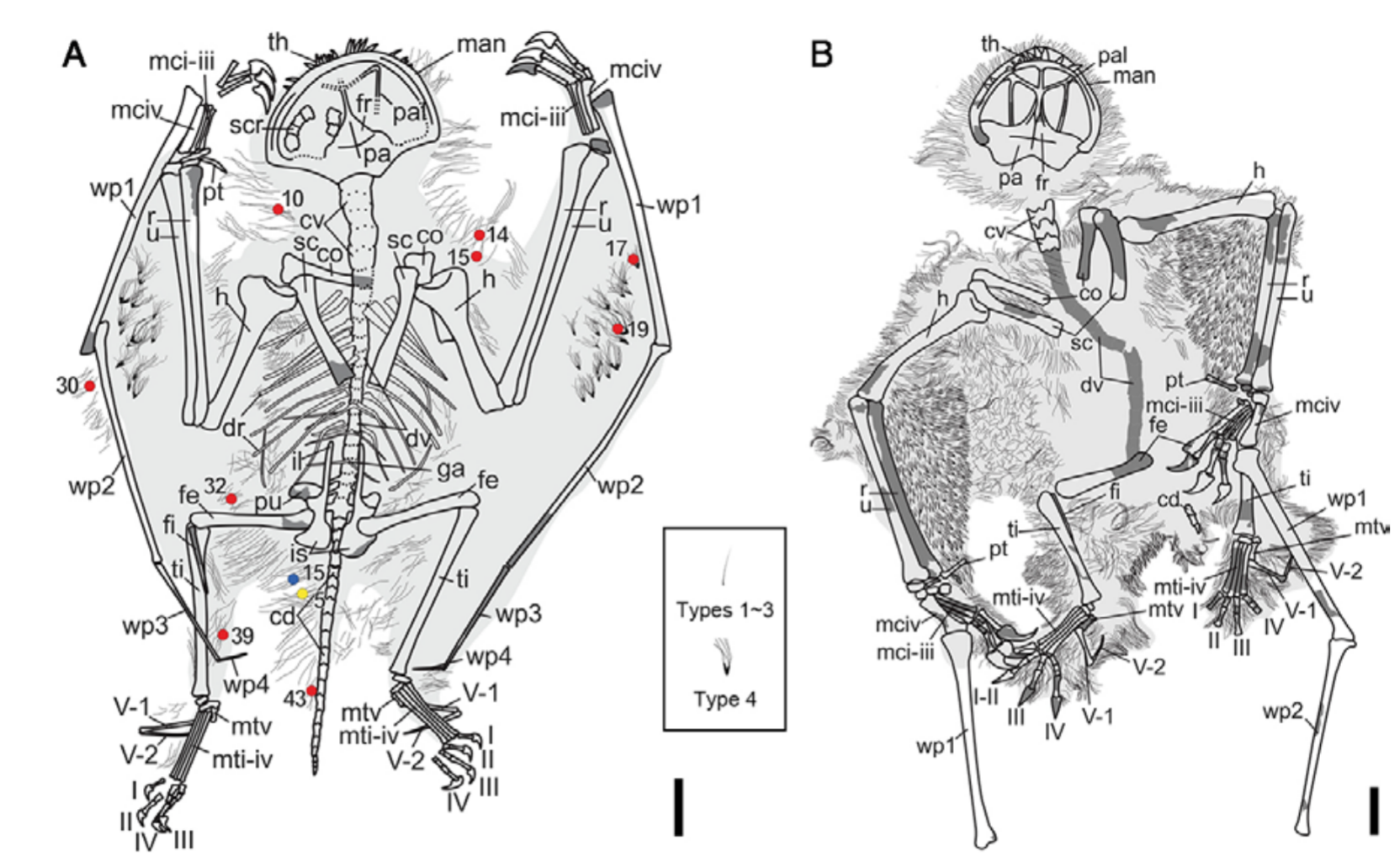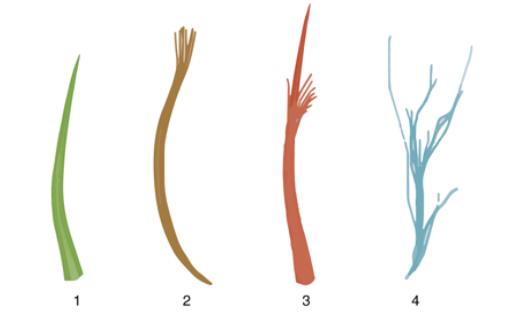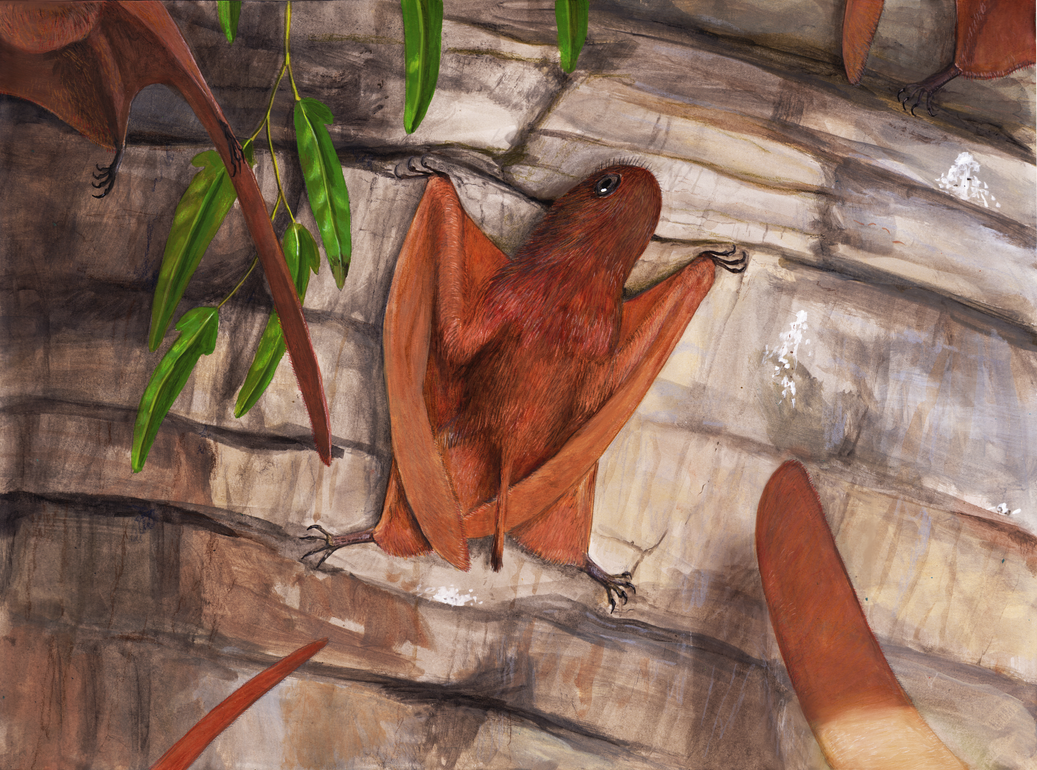
As you probably know, a recent paper reports complex branched filaments in two anurognathid specimens (Yang et al. 2019). While this hasn’t been the first time branched pycnofibres have been reported (Czerkas and Ji 2002, Cincotta et al. 2016), this is the most credible case yet. Since then I’ve seen a lot of discussion regarding this. Some of it has been kinda confusing. And some of the reports I’ve seen (particularly “pterosaurs have feathers now”) are potentially misleading. So let’s clear things up.
What is a feather?
A lot of the discussion and confusion I’ve seen regards whether pterosaurs have feathers now. I think a lot of this is because there hasn’t been a consistent definition of what a feather is – and therefore, whether the pycnofibres in these anurognathids qualify. Some have said that they do, because these pycnofibres branch. Some say they do, because they’re homologous to modern bird feathers. Some say they don’t, because true, complex feathers are only found in coelurosaurs. So what gives? I think a lot of it goes down to people not agreeing on what a feather is.
In this post, I’ll use the following definitions
- Feather: filamentous integument homologous with those in modern birds, of any complexity
- Pycnofibre: the filamentous integument of pterosaurs
- Monofilament: filamentous integument that does not branch
- Branching feather: well, a feather that branches
- Protofeather: a feather without a rhachis. This is admittedly an arbitrary definition, but it is done to distinguish earlier feather types from those found in modern birds
- Advanced feather: a feather with a rhachis. Again arbitrary.
Fuzz in Anurognathids
Previously, the only confirmed pycnofibre morphology in anurognathids was monofilamentous (present in Jeholopterus). These two specimens show a wide variety of pycnofibres. There are four types of pycnofibre: a monofilament, similar to those previously described in pterosaurs; a filament that branches distally, similar to the “paintbrush-like” feathers of scansoriopterygids; a monofilament with small projections about halfway through, similar to the sensory bristles of some modern birds; and filaments that share a base, similar to the “stage 2” feathers of coelurosaurs. The bristle-like pycnofibres are present around the mouth, presumably acting like nightjar rictal bristles (furthering the analogy between these two clades), while the “stage 2” pycnofibres cover the wings (yep – there are anurognathids even fuzzier than Jeholopterus!). They do not have filaments that look just like those in modern birds – the pycnofibres do not have distinct rhachises, no barbules, and all pycnofibres appear to have been still flexible. But the pycnofibres do resemble protofeathers of dinosaurs – to paraphrase Steve Brusatte, if you saw them on a dinosaur, you would call them feathers.

Are pycnofibres feathers?
Are pycnofibres homologous to feathers in dinosaurs? Did the ancestor of dinosaurs and pterosaurs have filamentous integument? Are pycnofibres feathers sensu this post? These are all the same question phrased in different ways. So far there have been three major ancestral state reconstructions regarding filamentous integument in ornithodirans. Barrett et al. (2015) concluded that the ancestor of ornithodirans, and filamentous integument evolved independently in pterosaurs, ornithischians, and theropods. However, they assume a priori that pycnofibres are not homologous to dinosaur feathers, and coded pterosaurs as “scaly” – which is a risky assumption. Indeed, when the ASR was ran with pycnofibres coded as homologous to dinosaur feathers, ancestrally feathered ornithodirans becomes the most likely possibility. Holtz (2018) also tested this, and found a similar conclusion – coding pycnofibres as homologous to dinosaur feathers makes ancestrally feathered ornithodirans likely, and coding pycnofibres as not homologous makes ancestrally feathered ornithodirans less likely. Clearly, the probability of ancestrally filamentous ornithodirans (and dinosaurs, for that matter) rests heavily on pycnofibres.
Yang et al. argue that pycnofibres are homologous to feathers, and code them so, finding ancestrally feathered ornithodirans most likely. Structurally and functionally, the two types of integument are pretty much identical. There are also no basal ornithodirans that preserve scales (which would indicate they evolved separately) – but then again, there are almost no basal ornithodirans with preserved integument at all. It should be noted that the most basal major ornithischian group – Heterodontosauridae – and potentially one of the most basal major pterosaur groups – Anurognathidae – both are fuzzy. There’s some stuff in the works that could indirectly indicate one way or the other in saurischians, but as it currently stands there just isn’t any well-preserved archosaur integument from before the early Jurassic.
That being said, if these filaments are not homologous, there are multiple instances of filament gain and filament loss within ornithodirans. If they are homologous, then there are still multiple instances of filament loss, but only one instance of gain. Multiple filament losses happen either way – we can be pretty confident the mechanism to do that existed, and happened multiple times regardless. It is the multiple filaments gains that lack direct evidence, so it becomes the less parsimonious option. And per Occam’s razor, the simplest hypothesis should be taken as the null.
TL:DR; if you say “feathers” are “all bird-line fluff”, then pycnofibres are probably feathers. They look like branched protofeathers, but don’t resemble the feathers of modern birds.
Are the branched pycnofibres the same thing as branched dinosaur feathers?
Yang et al. also conclude that the branching pycnofibres are homologous to the branching feathers of dinosaurs, and that branching feathers were also present at the base of Ornithodira. As mentioned earlier, these anurognathids are not the first report of branching pycnofibres. Pterorhynchus was reported to have pycnofibres that resemble ostrich feathers, rhachis and all (Czerkas and Ji 2002). The only copy I can find doesn’t have figures, and rumor has it the specimen is incredibly difficult to access (Adam Fitch, pers. comm.), so this claim cannot be independently verified. The lead author was also a BANDit (a proponent that birds did not evolve from dinosaurs), and the paper implies that pterosaurs and birds share an ancestor not shared by dinosaurs, so I would take this claim with a grain of salt. An undescribed tapejarid (which looks a lot like Tupandactylus) shows a mix of monofilaments and a type of branching pycnofibre (Cincotta et al. 2016). The latter resembles Stage 3 feathers, but from what I can see no distinct rhachis is visible (I like to call this state “stage 2.5”). The new anurognathids are currently the most credible instance of branching pycnofibres, though.
The branched pycnofibres in anurognathids are remarkably structurally similar to branched feathers in coelurosaurs, indeed, but I would caution that this may be a premature observation. If this were the case, you would expect to also see these filaments in ornithischians – but this isn’t the case. Tianyulong only shows monofilaments. Kulindadromeus has complex feathers, but they look nothing like those in anurognathids and coelurosaurs. Kulindadromeus has a feather type that appears to be hairlike filaments extending from a base plate, as well as a unique type of bundled ribbon-like filament. I’m not sure if it’s the best of ideas to code them identically to the branching filaments in anurognathids and coelurosaurs – I classify them separately in my feather type infographic for this reason. On the other hand, though, given the paucity of integument preserved in basal ornithodirans, it’s still entirely possible that branched filaments were present back then and just not preserved in Tianyulong for whatever reason. Who knows. Only further finds will be able to clear this up (or, as is almost always the case in paleontology, muddy things further).

This would not be the first time that something happened almost identically in numerous independent groups of ornithodirans. Toothless beaks evolved a minimum of 7 times in Ornithodira – and likely many more – each time with the anterior beak losing teeth first and moving posteriorly. As well, reticulate scales appeared on the majority of the body multiple times in dinosaurs independently. Presumably, the same genetic mechanism was present somewhere at the base of Ornithodira, and was expressed multiple times in each of these taxa. It wouldn’t be far out of the question that something similar happened with the filaments in pterosaurs and coelurosaurs.
As well, the identity of the “type 4” filaments has been questioned. They only appear on where the wing membranes should be, but aren’t preserved. David Unwin and Chris Bennett have both expressed skepticism that these structures are filaments, with the former suggesting that they could be degraded actinofibrils. A bit of uropatagium is preserved in one of the anurognathids and shows actinofibrils distinct from the branching filaments, but Unwin’s observation would be a striking coincidence. Only further studies will be able to tell us what the true nature of these structures are.
TL:DR; I don’t think the branching fuzz in pterosaurs and coelurosaurs are the same thing, but until further evidence comes up, it’s still in the air.
In Summary
Yang et al. 2019 is an important paper for multiple reasons. It’s the first report of branching pycnofibres in peer-reviewed literature, it adds further evidence to support the presence of feathers at the base of Ornithodira, it shows that some pterosaurs had pycnofibres covering the entire wings (probably), and it’s the first paper to determine the color of anurognathids (at least one was reddish!). It’s an exciting publication, and I look forward to any future studies on pterosaur fuzz.
As an aside, in life, these anurognathids would have probably been very cute.

References
Barrett, P.A.; Evans, D.C.; Campione, N.E. (2015). “Evolution of dinosaur epidermal structures“. Biology Letters 11(6).
Cincotta, A.; Godefroit, P.; Yans, J. (2016). “Study of preserved tissues in a tapejarid pterosaur“. XIV Annual Meeting of the European Association of Vertebrate Palaeontologists, Haarlem.
Czerkas, S.A.; Ji, Q. (2002). “A new rhamphorhynchoid with a headcrest and complex integumentary structures.” In: Czerkas, S.J. (ed.). Feathered Dinosaurs and the Origin of Flight. The Dinosaur Museum: Blanding, 15-41.
D’Alba, L. (2019). “Pterosaur plumage“. Nature Ecology & Evolution 3: 12-3.
Godefroit, P.; Sinitsa, S.M.; Dhouailly, D.; Bolotsky, Y.L.; Sizov, A.V.; McNamara, M.E.; Benton, M.J.; Spagna, P. (2014). “A Jurassic ornithischian dinosaur from Siberia with both feathers and scales“. Science 345(6195): 451-5.
Holtz, T.R. (2018). “‘Integumentary Status: It’s Complicated’: Phylogenetic, Sedimentary, and Biological Impediments to Resolving the Ancestral Integument of Mesozoic Dinosauria”. 78th Annual Meeting of the Society of Vertbrate Paleontology, Albuquerque.
Yang, Z.; Jiang, B.; McNamara, M.E.; Kearns, S.L.; Pittman, M.; Kaye, T.G.; Orr, P.J.; Xu, X.; Benton, M.J. (2019). “Pterosaur integumentary structures with complex feather-like branching“. Nature Ecology & Evolution 3: 24-30.


Is there a link for the Holtz 2018 paper so that I can read it? Because when I try searching it in Google Scholar, it’s not there.
LikeLike
Not a paper – Holtz 2018 was a poster presented at the 2018 Society of Vertebrate Paleontology conference
LikeLike
My mistake.
Is there a link for the poster?
LikeLike